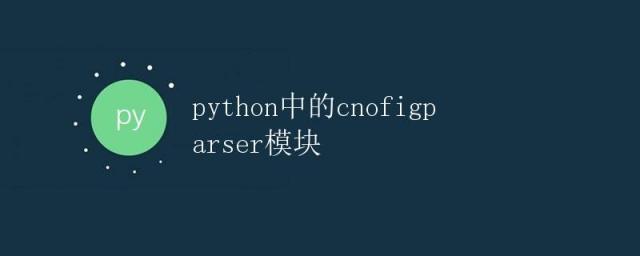Python中的configparser模块
2024年04月27日 Python中的configparser模块 极客笔记
Python中的configparser模块

在Python中,我们经常需要读取和操作配置文件,来存储程序运行时需要的参数和设置。Python的configparser模块就是为了方便地处理配置文件而设计的。这个模块提供了一个ConfigParser类,可以用来读取和写入INI格式的配置文件。
INI文件格式
INI文件是一种简单的配置文件格式,它由一系列的节(section)组成,每个节包含一系列的键值对。INI文件的基本结构如下所示:
[section1]
key1 = value1
key2 = value2
[section2]
key3 = value3
key4 = value4
在这个示例中,有两个节(section1和section2),每个节下面有对应的键值对。使用INI格式可以很好地组织和管理配置信息。
ConfigParser模块的基本用法
首先,我们需要导入ConfigParser模块:
import configparser
然后,我们可以创建一个ConfigParser对象,并使用read()方法来读取一个INI文件:
config = configparser.ConfigParser()
config.read('config.ini')
假设我们的config.ini文件内容如下:
[database]
host = localhost
user = root
password = 123456
我们可以通过get()方法来获取指定节下的键值对:
host = config.get('database', 'host')
user = config.get('database', 'user')
password = config.get('database', 'password')
print(f"Database host: {host}")
print(f"Database user: {user}")
print(f"Database password: {password}")
运行上述代码,输出为:
Database host: localhost
Database user: root
Database password: 123456
写入配置文件
除了读取配置文件外,ConfigParser对象还可以用来写入配置文件。我们可以使用set()方法来设置指定节下的键值对,并使用write()方法将配置信息写入文件:
config.set('database', 'port', '3306')
with open('config.ini', 'w') as configfile:
config.write(configfile)
这段代码会在config.ini文件的database节下添加一个port键值对。最后,我们使用write()方法将更新后的配置信息写入文件中。
处理多值
有时候一个键对应的值可能是一个列表或元组,ConfigParser也提供了处理这种情况的方法。我们可以使用get()方法的getint()、getfloat()、getboolean()、getlist()等方法来获取特定类型的值:
[server]
ip = 127.0.0.1, 192.168.1.1, 10.0.0.1
ip_list = config.get('server', 'ip')
ip_list = config.getlist('server', 'ip')
print(ip_list)
总结
ConfigParser模块提供了一种简单而有效的方法来读取和写入INI格式的配置文件。通过ConfigParser类提供的方法,我们可以方便地操作配置文件中的节、键和值,从而实现程序的配置管理功能。当我们需要存储程序运行时的参数和设置时,INI格式的配置文件是一个非常好的选择。
本文链接:http://so.lmcjl.com/news/3224/